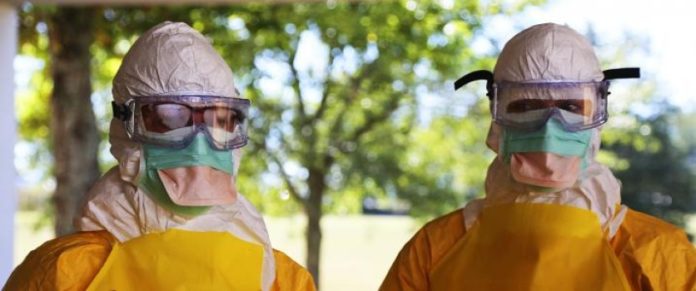
Hygienic funeral practices, case isolation, contact tracing with quarantines, and better protection for health care workers are the keys to stopping the Ebola epidemic that continues to expand in West Africa, researchers said today in a new report in the journal Science.
Continuing the status quo of intervention efforts that were in place as of Sept. 19 would allow continued expansion of the epidemic by about 224 new cases daily in Liberia by Dec. 1, and 348 new daily cases by Dec. 30, the scientists reported in their analysis.
However, they said broad implementation “with utmost urgency” of more aggressive approaches they recommended, used at a reasonably high level of efficiency, could by mid-March lead to its control in Liberia, the focal point of the epidemic.
Researchers from Yale University, Oregon State University, and Liberia concluded that funerals, as they have been customarily practiced in this region, were what they called “super-spreader events” that have had a disproportionate impact on the early transmission of the virus.
Changes in those practices are the single most important, practical step that could help place the number of new Ebola infections on a downward path. But a whole suite of actions are needed, they cautioned, and just reducing transmission in hospitals and the community will not by itself bring the epidemic under control.
“The cultural body preparation and funeral practices that are common in West Africa have driven the initial spread of this disease,” said Jan Medlock, an assistant professor in the OSU Department of Biomedical Sciences and an expert in mathematical epidemiology and evolution of infectious disease.
“These funeral practices often included washing, touching and kissing of bodies that were still capable of spreading the Ebola virus,” Medlock said. “It is imperative that funeral transmission be stopped, and also that we take other aggressive steps to isolate cases and better protect health care workers.”
The findings were made with complex mathematical models that consider many variables in how the disease is spreading, what steps are being taken to slow its progression and how effective those steps are. The research sought to identify not only what would theoretically work, but what was most practical and achievable.
The goal, the researchers said, should be to shift the current Ebola epidemic from one that is expanding to one that is slowly declining — to change what scientists call the “basic reproductive number” to less than 1, so the epidemic is on the road to ultimate extinction. They estimated that in Liberia the Ebola reproductive number is currently 1.63, meaning that two infected people would infect, on average, about three more people, and the epidemic continues to expand.
Getting that reproductive number below 1 will require adequate and proper use of personal protective equipment, more complete case isolations, contact precautions, quarantines, and particularly improved funeral practices. Achieving these goals at a success rate of about 60 percent could ultimately curtail the epidemic, the researchers said.
To arrive at their conclusions, the scientists used mathematical analysis to consider such factors as the density of infected and uninfected people in an area, numbers attending a funeral, those hospitalized, their relatives, health care workers in the hospital, and the general community.
Instead of traditional burial preparations, the researchers endorsed a very hygienic approach that includes disinfecting the cadaver before placing it in a plastic body bag and doing further disinfecting. Human-to-human transmission of Ebola occurs mostly through direct or indirect contact with body fluids, the researchers noted in their report, and deceased victims still carry a high viral load in their blood and excretions.
Another significant concern, the researchers said, is under-reporting of cases, both in hospitals and the general community. This could slow the stoppage of the epidemic and increase the level of intervention needed to stop it.
Other things could also change as the epidemic evolves. Funeral attendance and traditional burial practices may decline as awareness builds about the disease, but contacting people who may have been exposed could become even more difficult as people move from urban to rural areas.
This study was supported by the National Institutes of Health and the Notsew Orm Sands Foundation. It was a collaboration of researchers from the OSU College of Veterinary Medicine, the Yale School of Public Health and the Ministry of Health and Social Welfare in Liberia. The corresponding author was Alison Galvani at the Yale School of Public Health. It is being published in the journal Science at its online Science Express web site.
The findings of this study were specific to Liberia but should have some relevance to other places with similar cultural practices or approaches to disease management, Medlock said. They are less relevant in situations where the disease has spread beyond Africa into the United States, Europe and other parts of the developed world, he said, where aggressive isolation and containment of infected people or quarantine of those exposed is more practical.
Given the magnitude of this health crisis, it’s already apparent that Ebola poses an international threat which requires an international response and aid, the scientists said in their conclusion.
“Ebola poses an urgent threat not only to West Africa but also to the international community,” they wrote.
“The implementation of effective interventions needed to reverse the growth of the Ebola outbreak in impoverished West African countries will be logistically challenging even with substantial international aid, but impossible without it.”
Story Source:
The above story is based on materials provided by Oregon State University. Note: Materials may be edited for content and length.
Journal Reference:
- Abhishek Pandey, Katherine E. Atkins, Jan Medlock, Natasha Wenzel, Jeffrey P. Townsend, James E. Childs, Tolbert G. Nyenswah, Martial L. Ndeffo-Mbah, and Alison P. Galvani. Strategies for containing Ebola in West Africa. Science, October 2014 DOI: 10.1126/science.1260612
